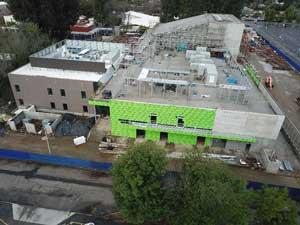Construction & Renovation Projects
CURRENT PROJECTS
The following are current construction projects at LA Valley College:
Academic Complex 1
Projected completion: 2025
The Academic Complex 1 (AC1) project, which is currently being designed, consists of a new 80,000 SF building, new vehicular parking with passenger pick-up/drop-off area, underground stormwater tanks, and approximately 165,000 SF of site development. The building will contain space for curriculums such as Business, Computer Science, Information Systems, Math, Psychology, Sociology, Ethnic Studies and Emergency Services.
Additionally, the scope will include connections to LAVC’s Central Plant, site & building utilities, new and existing City utility connections, disconnections, and relocations, new ADA paths of travel, and improvements to the Burbank Blvd. and Ethel St. right-of-ways.

Artist's rendering of the southwestern side of Academic Complex 1
Academic Building 2
Projected completion: 2026
The Academic Building 2 (AB2) will be the new home of the Communication Studies, English, English as a Second Language (ESL), Foreign Language, and Technology departments.
The new approximately 60,000 SF two-story building will be located in the northwest area of the campus, on the site of the college's Theatre Arts building. The Theater Arts building was demolished as a separate project.
AB2 integrates sustainable building features throughout the interiors and exteriors of the project. Designed to exceed Title 24 by 15%, the building’s MEP systems will optimize energy efficiency and reduce carbon emissions. The “cool roof” will reduce the heat island effect and the building landscaping is designed to reduce its water use by 50%.

Artist rendering of east entrance of Academic Building 2
On April 22, 2024, the Valley College celebrated a groundbreaking for the Academic Building 2.
Valley Academic & Cultural Center
Projected completion: 2025
The new Valley Academic & Cultural Center (VACC), which is being constructed on the northwestern part of the campus, will nurture the spirit of creativity and discovery, inspiring the artists, performers and producers within. The building will bring the Media Arts Department and the Theater Arts Department into a single complex—for a more collaborative learning environment.
The VACC will feature classrooms, study and rehearsal spaces, newsroom, radio station, faculty offices, and four separate theaters, including a 450-seat Mainstage Theater, a 225-seat Screening Theater, a 150-seat Horseshoe Theater, and an 80-seat Lab Theater. There will also be an Outdoor Amphitheater for outdoor performances and concerts.
For more information regarding the Valley Academic & Cultural Center, visit the BuildLACCD Web site.
Stadium Switchgear Replacement
Projected completion:
The project is a remodel of an existing electric room at the Los Angeles Valley College Monarch
Stadium. The existing switchgear is quite old and barely functions. The wood-framed structure that houses the switchgear is deteriorating at the walls and roof. This allows inclement weather to enter the space which poses an electrocution hazard during the rainy season. This project will include a remodel of the electric room structure and replacement and commissioning of new modern electrical equipment.
COMPLETED PROJECTS
The Campus Road North & South Stormwater Improvements project added storm water collection and retention improvements on College Road North and College Road South, as identified in the LAVC Stormwater Master Plan.
The project included the construction of vegetated bio-retention swales along the west edge of Campus Road North & South that captures stormwater, enabling it to percolate down into the ground instead of running into the City street. The scope also included roadway resurfacing and provisions for security camera surveillance and emergency blue phones.
The Coldwater Canyon Extension Stormwater Improvements project includes storm water collection and retention improvements as identified in the LAVC Stormwater Master Plan.
The project constructed vegetated bio-retention bulb outs along the east and west edges of Coldwater Canyon Extension Roadway capture stormwater enabling it to percolate down into the ground instead of running into the City street. The scope also included roadway resurfacing, sidewalk widening, new pole mounted street lights, and the addition of both a security camera surveillance system and an emergency blue phone system.
This project includes the demolition of Bungalows 80-85 which are currently used as a swing space.
This Phase 1 project installed special door hardware at all teaching spaces to enable doors to be locked quickly faculty, staff, and students in the event of an active shooter or other emergency situation that requires a lockdown sheltering-in-place.
The Audio Visual Upgrade project replaced the Audio Visual systems in Allied Health Sciences, Music, and Art. The work included new projectors, screens, audio systems, document cameras, auxiliary inputs with adapters, ADA-compliant lecterns, and switching hardware that enhances the overall learning experience for students.
This is the first phase of the Security Camera Upgrade project that replaced 65 cameras to provide better coverage, resolution, and operability. The work included a complete system overhaul including a cleaning of existing devices, all of which will result in a more reliable video surveillance system. The project also provided additional storage capacity for extended video image playback.
The Energy Infrastructure Improvement (EII) project included the construction of an above-ground chilled water thermal energy storage (TES) tank and associated 12” underground piping, pumps & vault. In addition, it will replace six existing central plant pumps, replace the existing central plant 900-ton McQuay chiller.
The project also replaces the existing steel gas pipes with new pipes from the Central Plant to the north part of the campus where it connects to the Art Building, Music Building, and the new Valley Academic and Cultural Center.
For more information, read the LAVC Central Plant Study.
The scope of work for this Multicultural Center project provided funds for new furniture, fixtures, and equipment (FF&E) required to repurpose the old bookstore area within the Campus Center Building. The space, now called the Unity Center, is the new home to the Dream Resource Center, LGBTQ+, and Puente programs.
The Allied Health and Sciences Center Lab Building project completed outstanding issues with the building envelope, which included waterproofing exterior locations subsequent to third party testing's and analysis.
This is the second phase of the Transportation and Accessibility Improvements (TAI) project in support of the college’s ADA/504 Transition Plan to remove barriers for individuals with disabilities. Campus-wide accessibility improvements included the North and South Gym walkways and ramps, the Music Building wheelchair lift, doors of the Library Building to automate them, the Planetarium walkways and ramps, and more.
This project demolished the old bungalows on the south side of the campus near the intersection of Ethel Avenue and Burbank Boulevard. It included lead and asbestos abatement and the subsequent demolition of Bungalows 1-77. The demolition included, but was not limited to, the removal of deteriorating planters, stairs, ramps, railings, and asphalt paving.
The scope for the Allied Health & Science Center Project included improvements to the building’s exterior envelope including waterproofing, metal flashings, expansion joints, and Densglass. The project also improved interior drain systems, accessibility for the disabled, and structural support of laboratory fume hoods.
This project upgraded the entire audio visual system for Music Room 100 including a new projector, screen, speakers, sound amplification components, and a control system to enhance the learning experience for music students. The system enables improved mobile collaboration via a mobile document camera that projects an Instructor’s keyboard movements.
This project upgraded the access control panel, card readers, and wiring for the Omega Data Center to allow access only to authorized users through dual-authentication protocols ensuring more effective security and management.
This Transportation and Accessibility Improvements (TAI) project was completed in June 2020. It included campus-wide accessibility improvements throughout the campus at several campus buildings, at both interior and exterior spaces, in support of the college’s ADA/504 Transition Plan to remove barriers for individials with disabilties. The project included accessibility improvements to doors, walkways, ramps, railings, drinking fountains, restrooms, signage, parking areas, and more.
Phase 2 of the Gymnasium Complex project was completed in June 2020. Work included completing the renovation of the existing North and South Gymnasium buildings. The renovated facilities include a space for educational and athletic departments/programs, a new dance studio, heating and cooling upgrades, new electrical systems and lighting, and fire alarm and sprinkler upgrades.
This campus-wide WiFi Upgrade project replaced 450 wireless access points, with upgraded Wifi devices, throughout the LAVC campus. This provided better coverage and higher bandwidth for faculty, staff and students alike. The project also included a new wireless controller to establish redundancy, and a new security platform for user authentication.
This first phase of the Access Control Project upgraded the access control panel, card readers, and wiring for the Business Journalism and the Allied Health Sciences buildings with the latest access control technology. The project also included training and certification of facilities staff in the operation and maintenance if the Lenel platform.
The Video Surveillance project upgraded and consolidated two (2) Video Surveillance Management Systems to a single platform to allow more effective monitoring and control of all security cameras on campus. The project included a more robust video wall and workstations to establish multiple monitoring points.
The Firewall Upgrade project replaced existing EOL firewalls for LAVC and the District which has provided robust security, standardization, and centralized management for the entire LAVC campus and District computer network.
The Administration and Career Advancement building (formerly known as the Community Workforce Development Center as well as the Valley Glen Gateway) replaced the old Administration Building near the college's main entrance.
The Administration and Career Advancement building is a two-level 41,000-square-foot building designed to serve as a new gateway to Valley College. It houses college's administrative offices, college services, and classrooms and meeting spaces.
The building is home to the LAVC President's Office, the Academic Affairs Office, the Administrative Services Office, LAVC Foundation, Institutional Effectiveness Office, Public Relations Office, Personnel Office, Payroll Office, Budget Office, Contracts/Purchasing (Procurement Office), Master Calendar Office, Reprographic Services, Mailroom, Campus Operator, Workforce Training (Job Training Office and Cooperative Education), the Academic Senate Office, CalWORKs, and Continuing Education/Non-Credit.
A groundbreaking ceremony for the Administration and Career Advancement building was held on January 15, 2015. The building was completed in late 2016, and a ribbon cutting ceremony will be scheduled in Summer 2017.
The building recieved a LEED Gold (Leadership in Energy and Environmental Design) from the U.S. Building Council.
For more information regarding the Administration & Career Advancement building, visit the BuildLACCD Web site.

Artist rendering of the exterior of the Administration and Career Advancement building.
A second phase of the Community Services project, which includes the demolition of the old Community Services and old Gymnastic Center kwansit huts, began on February 2016. The project includes the construction of the football practice fields, a walking track for the community to use, a new Parking Lot F, and a continuation of the the alumni walk on east side of Ethel Avenue. The project was completed in October 2016.
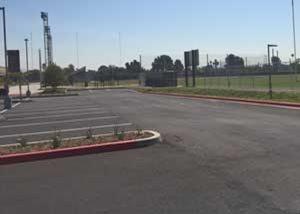
Newly paved Parking Lot F and the community Walking Track featuring new exercise stations are located south of Community Services Center.
The award-winning Student Union (previously called the Monarch Center), is a new hub of activity for students, faculty, staff and visitors at the "heart" of the campus. It is the third LEED Silver (Leadership in Energy and Environmental Design) building on campus, which was certified by the U.S. Building Council.
As a new gathering and meeting place for students, the 41,000-square-foot Student Union brings together student-centered services such as the Cafeteria, Campus Bookstore, Student Health Center / Student Psychological Services, Business Office, and the Associated Student Union (ASU) offices. Located adjacent to the new Parking Structure, it is also home to the new Lion's Den, a dedicated space for students to gather and relax between classes, as well as a coffee/snack bar.
One of the highlights of this new building is a unique "skybox" feature with panoramic views of the campus from the outdoor patio and walkway, with sheltered seating underneath for student gatherings. In addition, the new cafeteria dining area opens up to the covered outdoor patio that can be used as a student event plaza.
The Cafeteria, Business Office, Student Health Center / Student Psycholocial Services and Student Life Office moved in the building in February 2016 and the Bookstore and Lion Cafe moved in April 2016.
A groundbreaking ceremony was held on October 27, 2014. LAVC held official dedication ceremony on December 7, 2016.
The building has also recieved numberous awards for its excellent design and construction. To date, the project has recieved the following awards:
For more information regarding the Student Union, visit the BuildLACCD Web site.
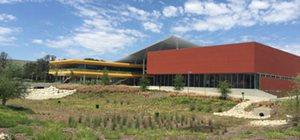
The Student Union opened in the Spring 2016 and is home to the college's bookstore, cafeteria, coffee cafe, business office, and the student health center/student psychological services.
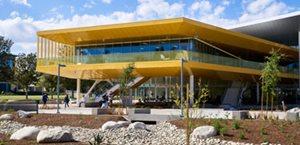
The Student Union's eyecatching yellow "skybox" houses the student life office, a student lounge, a student study room, and a student government conference room.

An artist rendering of the exterior of the Student Union.

An artist rendering of the Cafeteria dining area.
The Monarch Athletic Center (formerly known as the athletic training facility) will include new 23,000 SF stadium field house, which will house the the football team, soccer team, and track/field. The new stadium field house will include coaches office, locker rooms, and equipment rooms. It will also include two large classrooms and a weight room. The project will also include adding a new baseball and softball fields.
The building recieved a LEED Silver (Leadership in Energy and Environmental Design) from the U.S. Building Council.
The college held a groundbreaking ceremony on January 15, 2015. A ribbon cutting ceremony for the building was held on December 7, 2016.

A rendering of the overhead view of the Athletic Training Facility, which will be located adjacent to Monarch Stadium, and the new baseball and softball fields.
Kent Twitchell's iconic mural "The Old Woman of the Freeway" (or "Freeway Lady") has found its new home on the side of the college's Student Services Center.
Originally painted near the Hollywood Freeway, the mural was lost when it was painted over in 1986. After many years of trying to resurrect this iconic piece of Los Angeles public art, the LAVC Public Art Committee selected the repainting of Twitchell's "Freeway Lady" to be the first public art project on the campus.
The mural was completed in Fall 2015. The college held an official unveiling event for the Freeway Lady on April 14, 2016.

Kent Twitchell in the process of installing the "Freeway Lady" mural on the northwest side of the Student Services Center. The mural, which was completed in Fall 2015, can be seen from Fulton Avenue.
The new Alumni Walk, which was completed as part of the Community Services Center project, now serves as a new walkway to the Athletics area of the campus. This newly landscaped area is located between the Aquatics Center and the South Gymnasium. The area will feature special alumni brinks, with names of LAVC alumni who have purchased a commemorative brick through the LAVC Foundation.
The 18,000-square-foot Community Services Center (CSC) is the new home of the LAVC Community Services, Gymnastics Center and Monarch Summer Camp. The building is located on the southeastern corner of Ethel and Hatteras and next to Monarch Stadium and the Monarch Athletic Center.
The CSC is a multipurpose facility with a unique combination of instructional, activity and administrative spaces. The instructional zone features a dividable lecture hall designed to accommodate a variety of Community Services programs, and a Computer Lab that will be used as an Athletics Study Hall during the day and an instructional classroom at night. The activity zone includes the Gymnastics Center and two large multi-purpose rooms for various dance, martial arts, community wellness and student activities. In addition, it features an indoor 30-foot climbing wall. The Administrative Zone houses the Community Services Program office suite.
The building was awarded a LEED Gold (Leadership in Energy and Environmental Design) certification from the U.S. Green Building Council. Green features include a bio-retention garden for collecting storm water run-off, natural ventilation throughout the CSC building for efficient air conditioning consumption, and natural lighting for efficient energy consumption.
The college held a groundbreaking ceremony for the Community Services Building on May 7, 2013, and the building was dedicated on March 24, 2015.
Construction of the second phase of the Community Services Center project, which includes the football practice fields, a walking track for the community to use, a new Parking Lot F, and a continuation of the the alumni walk on east side of Ethel Avenue, was completed in 2016.
The Community Services Center is the recipient of the 2016 San Fernando Valley Business Journal Commerical Real Estate Silver Award for Public Project, and a 2016 American Institute of Architects, San Fernando Valley Chapter (AIA SFV) Design Citation Award.
For more information regarding the Community Services Center, visit the BuildLACCD Web site.

A dedication event was held on March 24, 2015 to celebrate the opening of the Community Services Center. Pictured (from left to right): LAVC Community Services Parent Monica Alatorre, LACCD Board Member Mona Field, LAVC Community Services Center Student Darya Alatorre, LACCD Board Member Steve Veres, LACCD Board of Trustees President Scott Svonkin, Councilmember Paul Krekorian, LAVC President Erika Endrijonas, LACCD Board Member Nancy Pearlman, and LACCD Chancellor Francisco Rodriguez.
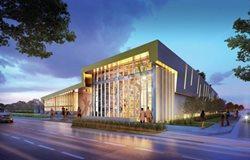
Artist rendering of the exterior of the Community Services Center

An artist rendering of the 30-foot indoor rock wall.

An artist rendering of the new gymnatics area.
Within the scope for the Campus Improvements, Building Upgrade includes interior and exterior improvements throughout the campus. The project also included heating and air conditioning (HAVC) improvements for the existing BDF rooms and a paint booth in the Maintenance & Operations Building. This project started in 2011 and was completed in 2015.
Construction of a new building to house the college's Omega Data Center, the Main Point of Entry (MPOE), a N.O.C., and Information Technology department office spaces. This project, which was completed in 2014, is part of the Community Workforce Development (CWFD) Center Project.
The new Parking Structure is centrally located next to the to-be-built Student Union, which will be new hub of activity for students, faculty, staff and visitors. It's location at the heart of the campus, will provide easy access to campus activities and athletic events.
The new four-level parking structure will provide the campus with 1,200 parking spots for students, faculty, staff and visitors. It will include a display noting the number of available parking spots on each level as well as charging stations for electric and hybrid vehicles.
Student and visitor vehicles will be able to access to the parking structure from Ethel Avenue. Faculty and staff will be able to access the parking structure from Emelita Street.
For more information regarding the Parking Structure, visit the BuildLACCD Web site.
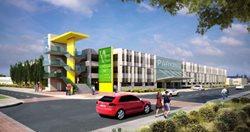
Artist renderings of the 4-story parking structure that provides more than 1,000 parking spots on campus for students, faculty, staff and visitors. Public access to this structure will be available on Ethel Avenue.

The parking structure is located near the "heart of the campus" for easy access to campus activities and athletic events.
The college's Information Technology (IT) Department recieved infrastructure upgrades to the Omega Data Center (in the old Administration Building) and to the Alpha Data Center (in Campus Center). In addition, there were interior improvements to the Campus Center Building to provide offices and workspace for the IT Department.
In 2009, construction began on the new Library and Learning Resource Center. The 93,000-square-foot facility was built on the same site as the college's original library.
The new two-story library is one of the largest in the San Fernando Valley, playing host to more than 130,000 books and subscribing to more than 350 magazines and newspapers. The second floor of the building houses the Academic Resources Center, which is the new home for the Zuckerman Writing Center, Math Lab, Reading Lab, General Tutoring, a Computer Commons, and a Faculty/Staff Resource Center. In addition, it is the new home of the LAVC Historical Museum, which is also be located on the second floor.
The Library and Academic Resource Center – which was designed by Pfeiffer Partner Architects – features sustainable materials and attributes, such as a heat-reducing roof. The U.S. Green Building Council awarded the building with a LEED Gold (Leadership in Energy and Environmental Design) certification.
A groundbreaking ceremony was held on November 18, 2009, and a ribbon cutting event was held on October 15, 2012.
For more information regarding the Library & Academic Resource Center, visit the BuildLACCD Web site.

An evening photo of the Library & Academic Resource Center, which houses is one of the largest libraries in the San Fernando Valley. It features a state-of-the-art library, classrooms, tutoring labs, computer labs, a faculty/staff resource center, and the LAVC Historical Museum.

A ribbon cutting ceremony was held for the Library & Academic Resource Center on October 15, 2012. Pictured from L to R: LACCD Chancellor Daniel J. LaVista, LAVC Dean of Academic Affairs Sheri Berger, LACCD Board of Trustees Member Scott Svonkin, LACCD Board of Trustees Member Nancy Pearlman, LAVC President Susan Carleo, LACCD Board of Trustees President Steve Veres, and LA City Councilmember Paul Krekorian.

LAVC and District Officials held a groundbreaking ceremony on November 18, 2009. Pictured (from left to right): Dana Lubow of the LAVC Library, Deborah Kaye of the LAVC Professional Development Center, LACCD Board of Trustees Member Kelly G. Candaele, LACCD Board of Trustees President Mona Field, LACCD Board of Trustees Vice President Georgia L. Mercer, LACCD Board of Trustees Member Nancy Pearlman, LACCD Board of Trustees Member Sylvia Scott-Hayes, LACCD Board of Trustees Member Tina Park, LAVC President A. Susan Carleo, Sheri Berger of the LAVC Math Department, Scott Weigand of the LAVC Writing Center, LACCD Interim Chancellor Tyree Wieder, and LAVC ASU Vice President Ian Coyne.
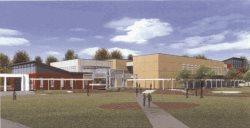
An artist rendering of the new Library & Academic Resource Center, which is located on the site of the college's former Library building.
As part of college-wide improvements to our parking lots and walkways, Parking Lot A and the southern portion of College Road South was renovated. The improvements to the area include improving traffic flow in the lot, adding additional parking spaces, creating a new pedestrian walkway to the Metro stop on Fulton Avenue and Burbank Boulevard, installing new parking lot lighting and new blue light emergency phone stations to ensure safety on campus, and erecting a college marquee to identify the campus and provide information on campus events and activities. Parking Lot A and College Road South reopened for public use on August 22, 2011.
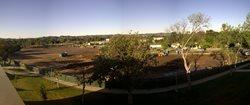
View of Parking Lot A and College Road South as the area is prepared for construction. All the asphalt and vehicular pathways in the area have been removed in the construction site. (May 4, 2011)
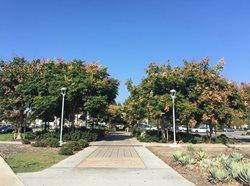
A pedestrian walkway leads from the MTA Orange Line bus stop to the Student Services Center & Annex.
Parking Lot D was renovated as part of Parking Lot/Internal Roads project. The project, which is located between the Maintenance & Operations building and the Child Development & Family Complex, included the installation of Photovoltaic arrays and resurfacing of the parking lot surface. In addition, a parking paystation was added to enable students and guests to purchase daily parking permits.
The Child Development & Family Complex is the new home of the Child Development Center, the Child Development department and the Family Resource Center. The complex, which started construction in 2008, comprises of three separate structures that provide child development courses, developmentally appropriate programs for children of students, faculty, staff, and the community, and special programs and services for the community.
The Child Development Center (CDC) offers developmentally appropriate programs including a Day Preschool Program (kids 3-5 years-old), a Afternoon After-Kindergarden Program (kids who attend kindergarden in the morning), and an Evening School-Age Program (kindergarden-13 years-old).
Adjacent to the CDC, is the Child Development Department (CDD) building, which includes four smart classrooms, faculty office spaces, a department reception area and a conference room that will be shared by the entire complex. These areas will be in addition to the classroom space currently in use in the Math Science Building.
The Family Resource Center (FRC) is a 2,000-square-foot, one-story, wood framed building featuring a large multi-purpose space with smaller support areas. Its focus is to train the early childhood workforce and to provide community families with programs for young children. The FRC is being built with a $1.5 million donation from the J.H. Synder Corporation, and it will be located adjacent to the new Child Development classrooms and offices and the new Child Development Center.
The Child Develooment & Family Complex recieved a LEED-certified (Leadership in Energy and Environmental Design) rating from the U.S. Green Building Council.
On August 7, 2008, the college broke ground on the Child Development & Family Complex. The district and college officials gathered at the building for a dedication ceremony on October 14, 2011.
For more information regarding the Child Development & Family Complex, visit the BuildLACCD Web site.

Celebrating the opening of the Child Development & Family Complex on October 14, 2011. Pictured (left to right): LAVC Child Development Center Director Terry Teplin, LAVC President Sue Carleo, LACCD Board of Trustees Member Mona Field, LACCD Board of Trustees Member Scott Svonkin, LAVC Family Resource Center Director Marni Roosevelt, and LAVC Child Development Department Chair Lauren Okayama.

Children from the LAVC Child Development Center sing a song about how much they love their new facility at the dedication event for the Child Development & Family Complex. The complex is home to the Child Development Center, Child Development Department, and the Family Resource Center.
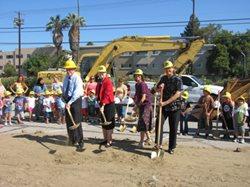
The children of the Child Development Center celebrate as LACCD and LAVC officials broke ground on the new Child Development & Family Complex on August 7, 2008. Pictured (from left to right): LACCD Chancellor Mark Drummond, LAVC President Sue Carleo, LACCD Board of Trustees Vice President Mona Field, and LACCD Board of Trustees Member Nancy Pearlman.

An artist rendering of the hallways of the new Child Development & Family Complex.

An artist rendering of the interiors of the new Child Development & Family Complex.
The new 70,000 square-foot Student Services Complex, which includes the Student Services Center & Student Services Annex, opened in 2010. Housed on the site of the former Physics and Chemistry building, the complex comprises of two adjacent buildings houses a variety of student services.
The following offices are now located in the new complex: Financial Aid, Counseling, Admissions & Records, Career Transfer Center, Business Office, Extended Opportunity Program and Services (EOPS), Disabled Students Programs and Services (DSPS), Personal Development Classroom, Student Outreach & Recruitment, Office of the Vice President of Student Services, Student Assessment Center and Placement Center.
The building complex received a LEED (Leadership in Energy and Environmental Design) certification from the U.S. Green Building Council.
The college held a groundbreaking on April 23, 2009 and a dedication event on November 15, 2010 to celebrate the new building.
For more information regarding the Student Services Center, visit the BuildLACCD Web site.
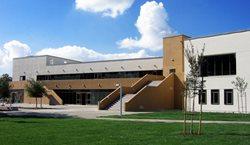
The $13.6 million Student Services Complex is a two-building facility that centralizes a majority of student services into one location on campus. Opened in 2010, the Student Services Center is home to Admissions & Records, Financial Aid, Assessment Center, EOPS, and TRiO, and the Student Services Annex is home to Counseling and Services for Students with Disabilities.
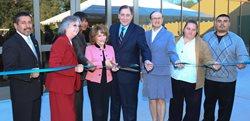
A dedication event and open house was held for the Student Services Complex on November 15, 2010. Pictured (from left to right): LAVC Acting Vice President of Student Services Florentino Manzano, LAVC President Dr. Susan Carleo, LACCD Interim Vice Chancellor for Educational Programs and Institutional Effectiveness, LACCD Board of Trustees President Georgia L. Mercer, LACCD Chancellor Dr. Daniel J. LaVista, LACCD Board of Trustees Second Vice President Nancy Pearlman, LACCD Student Trustee Linda L. Tong, and LAVC ASU Commission of Public Relations Christian Fierro.

A groundbreaking ceremony was celebrated by LAVC and LACCD officials on April 23, 2009. The building is scheduled to be completed in 2010. Pictured (from left to right): LACCD Board of Trustee President Mona Field, LAVC President Susan Carleo, LACCD Board of Trustee Member Nancy Pearlman, LACCD Chancellor Mark Drummond, LAVC ASU President Josh Wible, and LAVC Vice President of Student Services Yasmin Delahoussaye.
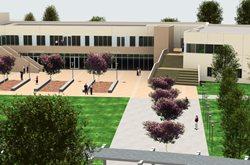
An artist rendering of the Student Services Center.
The Gymnasium Complex, which comprises of the North Gym, South Gym, and the Gymnastics Center, has been remodeled to include a new 5000 square-foot addition to the Adapted Physical Education Center and added a new Aquatics Center.
The North Gymnasium is home to a dance studio, health offices, fitness activity room, offices, main gymnasium, exercise room, and a conference room. It is being updated with a new roof, new paint, new dance floor and lighting in the Dance Studio, and new conference room furniture. The Adapted Physical Education Center, which is a state-of-the-art gym with specialized equipment for individuals with limited physical mobility or ability, has been added to the west side of the North Gymnasium. The new Aquatics Center includes an Olympic-sized swimming pool, a Community Services/Services for Students with Disabilities (SSD) pool, and a warm-up jacuzzi for divers.
Renovations to the South Gym include a new roof, new paint, some new furniture, new equipment and carpet in the Fitness Center, a new workroom and renovations to offices. The building houses the Physical Education department offices, a fitness center, team locker rooms, a training room, main gymnasium, equipment room, a satellite training room, and a buffet/kitchen.
The Gymnastics Center will have the roof repaired, new paint and new gymnastics equipment.
The college installed new signs for public safety and general campus information throughout the campus, including ADA signage.
The renovation of the Humanities Building took place in 2007. The building was updated with new energy efficient window, new doors, and new paint.
The Life Sciences (now the Emergency Services Training) Building and Planetarium were updated in 2009. The Planetarium was refurbished with an installation of a new elevator to the observation deck on the roof. In addition, the planetarium received new furniture.

Students sitting on the new furniture in the classroom inside the Planterium.

Planetarium has been renovated to include a new elevator to the observation deck, an upgraded dome and telescope and new furniture.
The Theater Arts Building was completed in 2008, and is home to the Mainstage, Horseshoe and Shoebox Theaters. This partial renovation to the building includes updating the theatrical lighting, rigging and equipment and a lighting system upgrade.
In addition, the building now has new seats and carpet in Horseshoe, new ticket booth, new entry, new seating on west exterior, completely change Shoebox theater (black box) with new lighting, new floor, new tile in halls, new offices, convert classrooms into smart classrooms.
In February 2009, Los Angeles Valley College opened its newly renovated main Fulton Avenue entrance and Monarch Square. The area was updated to create new walkways and roadways for students to access the campus and its facilities.
The Fulton Street entry has new lighting, asphalt concrete paving, walkways, handicap accessible ramps and stairs, a new bus shelter and bus/car drop off area, improved pedestrian lighting and new directional signage.
Monarch Square now has new walkways, lighting, directional signage, and landscaping that will include drought-resistant plants and a drip irrigation system, which is a water-saving method that minimizes water usage by allowing water to drip slowly into soil.
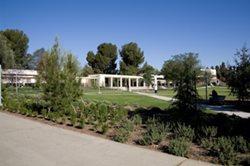
Monarch Square was renovated with new pedestrian pathways, benches and tables, and landscaping.

A part of the renovation to Monarch Square included adding new tables in the North Mall grass area for students to sit and relax between classes.
To meet the needs of our disabled students, a new Adapted Physical Education Center (APEC) has been added as a new 5,000 square-foot wing of the North Gymnasium. The facility, which was part of the Gymnasium Complex renovation, was opened to students in 2009.
The new 5,000-square-foot gymnasium includes an exercise room that be home to physical education classes for individuals with physical disabilities. It also contains specially adapted aerobic and weight training machines designed to accommodate the needs of students with disabilities, such as wheelchair accessibility. The new center, in conjunction with an accessible pool in the adjacent Aquatics Center, allows Valley College to provide a complete training and rehabilitation program for students and the community.
College and District officials celebrated the opening of the Adapted Physical Education Center (along with the Aquatics Center) on November 18, 2009.
For more information regarding the Adapted Physical Education Center, visit the BuildLACCD Web site.
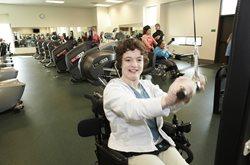
The Adapted Physical Education Center offers individuals with a documented disability to use specialized equipment. This state-of-the-art center has exercise equipment that can be used by individuals in wheelchairs.

Members of the community join LAVC students, faculty and staff in celebrating the opening of the new facility at the ribbon cutting event on November 18, 2009.
The college's central plant was upgraded to increase the college's energy efficiency through multiple energy components in the Central Plant, Campus Center and through an in-ground distribution system. This project included upgrades to equipment in the Central Plant including pumps and replacement of a chiller, replacement of the roof of the Campus Center building and the installation of new solar water heating tubes, and the completion of piping to close the utility loop at the north end of the campus. In addition, the Campus Center classrooms in the basement were updated with new paint and furniture.
The construction of The Belle & Harry Krupnick Media Arts Center (TV Studio) was completed in 2009. As an addition to the Motion Picture Building, this new facility provides a production/learning studio that is aligned with the new studio at CSUN and with local industry. It houses a new state-of-the-art television production studio where students can gain real-world skills on broadcast and motion picture production.
The building is named after Belle and Harry Krupnick, who donated $500,000 to the Los Angeles Valley College Foundation to help to establish a media arts program endowment.
A ribbon cutting event, which included members of the Krupnick family as well as district and college officials, was held on December 15, 2015.
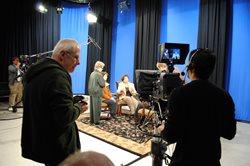
The building houses a new state-of-the-art television production studio where students can gain real-world skills on broadcast and motion picture production.
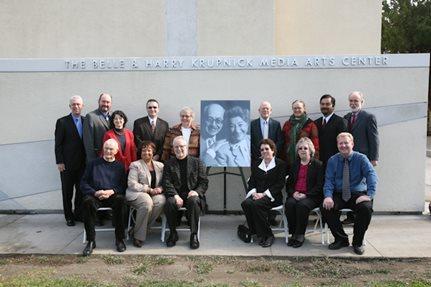
LAVC and LACCD officals, the Jewish Community Foundation of Los Angeles, and Krupnick family members of Belle and Harry Krupnick celebrated the opening of the new building on December 15, 2009. Pictured (from left to right): Jewish Community Foundation of Los Angeles CEO Marvin Schotland, LAVC Media Arts Department Chair Eric Swelstad, Krupnick family member, LAVC Media Arts Faculty Member Aranxta Rodriguez, LACCD Interim Chancellor Dr. Tyree Wieder, LAVC Foundation President Jason Schaff, LAVC Dean of Fine & Performing Arts Dennis Reed, Krupnick family member, Harry and Belle Krupnick (photo), Krupnick family member, Myra Roselinsky of the Krupnick family, LACCD Board of Trustees Member Nancy Pearlman, LAVC President Susan Carleo, LAVC Executive Director of the Foundation Raul Castillo, LAVC Media Arts Faculty Member Jason Beaton, and LAVC Media Arts Faculty Member Richard Holdredge.
A new Aquatics Center, which is located to the south of the North Gymnasium, was completed in 2008. As part of the Gymnasium Complex, which is home to North and South Gymnasiums and the Gymnastics Center, it will feature a new Olympic-sized swimming pool with diving boards and platforms, a training (Adapted Physical Education Center / Community Services) pool and a divers jacuzzi. A new pool equipment building is also house on site.
These pools are regularly used by the LAVC swimming and diving, and water polo teams, for physical education classes, and the community-at-large through our community services classes. The facility has benches and shade structures for spectators.
A dedication ceremony for the Aquatics Center (along with the Adapated Physical Education Center) was held on November 18, 2009.
For more information regarding the Aquatics Center, visit the BuildLACCD Web site.
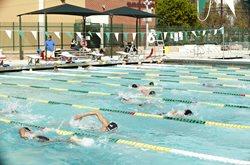
The Aquatics Center is used throughout the year by the LAVC Swimming, Diving and Water Polo teams, for physical education classes, and for community services classes.
In September 2008, the $46 million state-of-the-art Allied Health & Sciences Center opened to the public. The Center is the second new building funded by Proposition A/AA at Valley College. This new 98,000-square-foot building will house Life Science, Physical Science, Earth Science, Anthropology, and Health Sciences departments and boasts 131 new rooms, tutorial labs and faculty offices.
The new 3-story teaching lab and classroom facility will have lab and office wings that form a courtyard at the structure's center. Located on the site of former bungalows at the corner of Burbank Blvd. and Fulton Street, the new facility and its plaza will function as an entrance to LAVC as well as a destination point along the pedestrian thoroughfare that runs within the campus.
The building, which was designed by CO Architects, incorporates energy-saving and sustainable components. It features energy efficient heating and cooling systems and lighting, rooftop photovoltaic panels for generating electricity, and a storm water retention system in the landscaping. The building also will be flexible enough to accommodate changes in curriculum over the life of the structure. Ashen + Allen's Sarah Dennison is the Principal in Charge and Frances Moore is the Project Architect.
The building recieved a LEED Silver (Leadership in Energy and Environmental Design) certification from the U.S. Green Building Council, and was awarded a 2009 Green California Leadership Award in the category of "Green Building".
For more information regarding the Allied Health & Sciences Center, visit the BuildLACCD Web site.
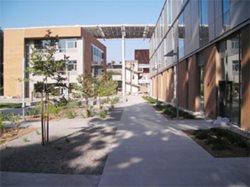
LAVC's new energy-efficient Allied Health & Sciences Center opened in Fall 2008.

A ribbon cutting of the Allied Health & Sciences Center on November 5, 2008. Pictured (from left to right): LACCD Board of Trustee Member Georgia Mercer, LACCD Board of Trustee Member Mona Field, LAVC President Sue Carleo, LACCD Chancellor Mark Drummond, LAVC Professor Karen Roy, LACCD Board of Trustee President Kelly Candaele, LACCD Board of Trustee Member Nancy Pearlman, LACCD Board of Trustee Member Sylvia Scott-Hayes, and LACCD Board of Trustee Member Angela Reddock.

On January 31, 2007, LAVC commemorated the placing of the final piece of steel on the new Allied Health & Sciences Center with a “topping off” ceremony. Pictured on the Left (from left to right): Professor Mary Cox, Professor Donald Gauthier, President Tyree Wieder, LACCD Board of Trustee Member Mona Field, Professor John Milligan, and Professor Karen Roy.
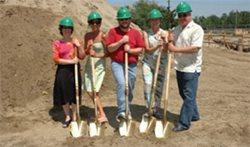
The new Allied Health & Sciences Building grounding breaking. Pictured (from left to right): Dean of Academic Affairs Laurie Nalepa, Nursing Department Chair Mary Cox, Professor John Milligan, Professor Karen Roy, and Professor Don Gauthier.

An artist rendering of the Allied Health & Sciences Center.
The Engineering Building was renovated in 2007. The building received new doors, energy efficient window, new paint and remote controlled overhead projectors in classrooms.
The Math/Sciences building was renovated in the summer of 2007. The building received new energy-efficient windows and new floors, overhead LCD projectors and marker boards were installed in classrooms, and the interior, ceilings and restrooms were painted.
Renovations to the Music Building and Recital Hall were done in two phases. In the first phase, which was back in 2007, the Music Building received new paint, new carpet in halls and Band Room, new practice rooms, and code upgrades. The Recital Hall, which hosts a variety of fine and performing art concerts for the community, got new paint, a new stage surface, new acoustical doors, new lobby entry, and a new ticket booth.
The second phase of construction for the Music Building and Music Recital Hall has been completed. The Recital Hall received new lighting, new interior doors and renovated seating. The final renovations to the Music Building include completing plaster and paint in Band Room, new equipment in Piano Room, and new smart classroom equipment.
In the summer of 2007, the Art Building completed its first phase of renovations, which included new floors in the halls, new display cases, new paint in rooms, a new tiled entry, a new disabled entry, and new lecture hall seating and flooring. Also in 2007, the building's Art Gallery, which regularly features art exhibitions, was expanded with new walls, a new black-painted ceiling, new lighting, a new security system, and new sliding glass entry doors that open into the Art Patio.
The second phase of renovations included new windows, new flooring to remaining rooms and offices, new lighting, paint to additional areas and doors, and revised seating in the lecture hall.
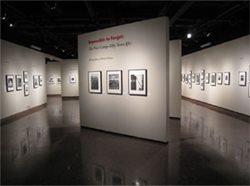
The LAVC Art Gallery showcases a number of public exhibitions every year. In 2008, it exhibited Nazi concentration camps photographs taken by renowned English photographer Michael Kenna.
The Business Journalism Building was renovated in 2007. The building was updated with new doors, energy efficient window, new paint and smart software equipment such as remote controlled overhead projectors.
The classrooms located on the 2nd Floor of the Campus Center Building were renovated in 2007. Classrooms were painted, and new overhead LCD projects and new white marker boards were installed.
Renovations to the Behavioral Sciences building were completed in 2007. New energy-efficient windows, new floors, new overhead LCD projectors and marker boards were installed, and the interior, ceilings and restrooms were painted.
In 2007, Valley College opened its new Concession Stand & Visitor Restrooms located on the south side of Monarch Stadium. The area contains a track storage room for athletic equipment, a ticket booth, a concession stand, and restrooms in Monarch Stadium for the visiting team. The area is also home to a recruitment patio, which is used for recruitment of prospective athletes, and special events.

Visiting team fans will be able to use the new Ticket Booth, and Concession Stand and Visitor Restrooms located on the south side of Monarch Stadium.
LA Valley College has a new state-of-the-art, 10-lane NCAA approved red and gray track and football/soccer field. Phase I of the project, which was completed in 2006, included a new synthetic football and soccer surface, a 1500-seat visitors' bleachers section, and a 4-lane public jogging track. Phase II will include the visitors' restrooms, ticket booth, a visitors' concession stand, and a new track equipment storage facility.
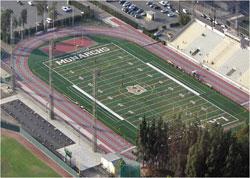
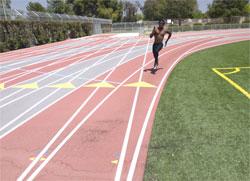
The LAVC Monarch Stadium is home to the first and only 10-lane Mondo Track in southern California.
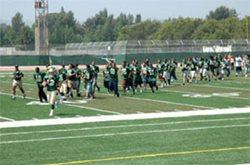
The LAVC Football Team runs onto to the new football/soccer field made of synthetic grass.
Campus restrooms were renovated in 2007. Restrooms were refurbished with new sinks, fixtures, paint, tiles, and restroom facilities, as well as updated for wheelchair access.


Renovations of the men's green, gray and dark blue restrooms are complete in the Campus Center and Math/Science buildings.
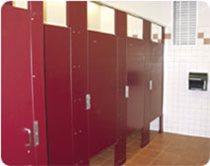
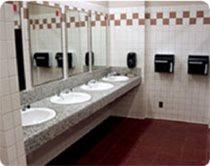
Remodeled women's restrooms in the Math/Science building and Campus Center are burgundy and white.
The Maintenance & Operations / Sheriff's Station opened to the public in 2006. This project, which was funded by Proposition A & AA, was the first LEED-certified (Leadership in Energy and Environmental Design) building built in the Los Angeles Community College District.
The $6.6 million, 28,000-square-foot, one-story facility that house maintenance equipment, shipping and receiving, warehouse offices, and Sheriff's personnel and operations. It consists of three connecting structures that form a compound with an inner courtyard. Valley College employs 75 electricians, plumbers, painters, carpenters, auto mechanics, locksmiths, gardeners, and custodians. In addition, the Sheriff's Station, which operates 24 hours a day, is the base for campus security officers, cadets, and Sheriff's administrative staff.
The Maintenance & Operations / Sheriff's Station received a LEED (Leadership in Energy and Environmental Design) certification by the U.S. Green Building Council.
For more information regarding Maintenance & Operations / Sheriff's Station, visit the BuildLACCD Web site.
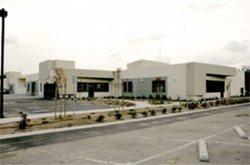
The Maintenance & Operations / Sheriff's Station opened in 2006. It is the first LEED-certified, environmentally sustainable building in the LACCD.
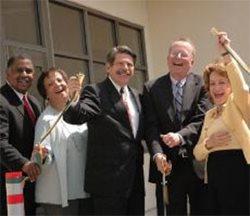
A ribbon cutting ceremony was held for the new Maintenance & Operations/Sheriff’s Station on April 20, 2006. Pictured (from left to right): Command Chief of the Community College Bureau Ronnie Williams, LAVC President Tyree Wieder, Los Angeles County Supervisor Zev Yaroslavsky, Los Angeles Community College District Chancellor Darroch "Rocky" Young and LACCD Board of Trustees member Georgia L. Mercer.
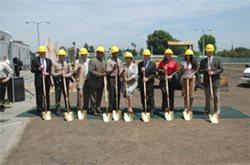
LAVC and LACCD officials broke ground on the site of the new Maintenance & Operations / Sheriff’s Station building. It was the first new building constructed on-campus in more than 30 years.
The exteriors of most campus buildings now have an earth-tone color scheme, as Phase I of the painting project. Phase II began in Fall 2005. The campus painting project included the Campus Center, Cafeteria, Main Arcade and overheads and walkways, refurbishing of college letters on the main archway, Planetarium dome, Bungalow 78, and the Stadium restrooms.
Renovations have been completed on Campus Center and Foreign Language buildings. The Campus Center interior has been painted, new marker boards have been installed in classrooms, and the roof deck has been replaced. In the Foreign Language, building, the interior has been painted, floors replaced, ceilings and restrooms painted, and new projectors and marker boards have been installed in the classrooms.

Painting the exteriors of most campus buildings is complete.
Los Angeles Valley College installed a new electronic Marquee on the northwest corner of the campus (off Oxnard Street and Fulton Avenue). The marquee displays information to the campus and the community about college events and news.

The new electronic marquee announces college events to the community on the corner of Oxnard Street and Fulton Avenue.
In 2006, the Monarch Patio was renovated to provide a gathering place for students in the Campus Center building as well as an outdoor area for the adjacent Monarch Hall. Sunshades were erected to provide shading for students using tables and chairs in the patio.

Students enjoying the new Monarch Patio, located next door to Monarch Hall, in the Campus Center building.
In 2006, the Art Patio located in the Art Building was remodeled to provide a space for students to study and relax, as well as for a space to hold receptions for the adjacent Art Gallery and for special events. The Art Patio was updated with new outdoor furniture, drought-resistant plants, a trellis and a fountain.

Students use the beautiful new Art Patio to study, hang out and relax between classes.
The Foreign Language Building was one of the first projects completed by Proposition A. The major renovations to the building was completed in 2005. The interiors were painted, floors replaced, ceilings and restrooms painted, and new projectors and marker boards have been installed in the classrooms. The classrooms also have new window coverings.
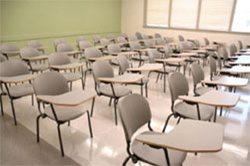
The Foreign Language Building was the first building to be renovated with smart classroom technology.



